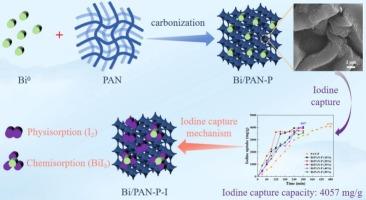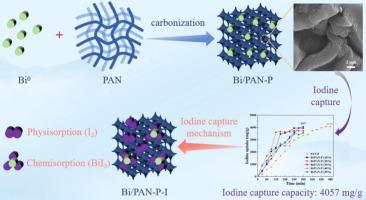Polyacrylonitrile-loaded bismuth (Bi) porous carbon materials for efficient adsorption of iodine vapour
IF 6.9
2区 材料科学
Q2 CHEMISTRY, PHYSICAL
引用次数: 0
Abstract
Bismuth-based materials are regarded as green materials for dealing with radioactive iodine. However, the sole use of Bi has problems such as agglomeration. Dispersing Bi in the matrix material to overcome the disadvantage of Bi’s easy agglomeration to prepare Bi-based composites with low cost and high adsorption capacity is an urgent need for iodine gas capture. Here, five kinds of Bi-containing polyacrylonitrile (PAN) porous carbon materials (Bi/PAN-P) were prepared by thoroughly mixing Bi as adsorbent with contents of 10 wt%, 20 wt%, 30 wt%, 40 wt% and 50 wt%, PAN as the matrix and dimethyl sulfoxide (DMSO) as the solvent, and then carbonizing. The results show that the Bi loaded on Bi/PAN-P is uniformly distributed and the material is mainly mesoporous. It has a rapid adsorption rate for gaseous iodine, reaching more than 50 % of the maximum adsorption capacity within the first 90 min, and its speed far exceeds the adsorption rate of pure PAN carbon materials. Especially when the Bi content is 30 wt%, the iodine adsorption capacity reaches 4057 mg/g, which is about 20 times that of commercial silver exchange zeolite. Based on experimental and model simulation results, the adsorption of iodine by Bi/PAN-P mainly through chemical adsorption.


聚丙烯腈负载铋(Bi)多孔碳材料对碘蒸气的高效吸附
铋基材料被认为是处理放射性碘的绿色材料。但单用铋存在结块等问题。将Bi分散在基体材料中,克服Bi易团聚的缺点,制备低成本、高吸附能力的Bi基复合材料,是碘气捕获的迫切需要。以Bi为吸附剂,以10 wt%、20 wt%、30 wt%、40 wt%和50 wt%为吸附剂,PAN为基体,二甲亚砜(DMSO)为溶剂,进行充分混合,制备了5种含Bi的聚丙烯腈(PAN)多孔碳材料(Bi/PAN- p)。结果表明:负载在Bi/PAN-P上的Bi分布均匀,材料以介孔为主;它对气态碘的吸附速度很快,在前90 min内可达到最大吸附量的50% %以上,其吸附速度远远超过纯PAN碳材料的吸附速度。特别是当Bi含量为30 wt%时,碘吸附容量达到4057 mg/g,约为商品银交换沸石的20倍。实验和模型模拟结果表明,Bi/PAN-P对碘的吸附主要是化学吸附。
本文章由计算机程序翻译,如有差异,请以英文原文为准。
求助全文
约1分钟内获得全文
求助全文
来源期刊

Applied Surface Science
工程技术-材料科学:膜
CiteScore
12.50
自引率
7.50%
发文量
3393
审稿时长
67 days
期刊介绍:
Applied Surface Science covers topics contributing to a better understanding of surfaces, interfaces, nanostructures and their applications. The journal is concerned with scientific research on the atomic and molecular level of material properties determined with specific surface analytical techniques and/or computational methods, as well as the processing of such structures.
 求助内容:
求助内容: 应助结果提醒方式:
应助结果提醒方式:


